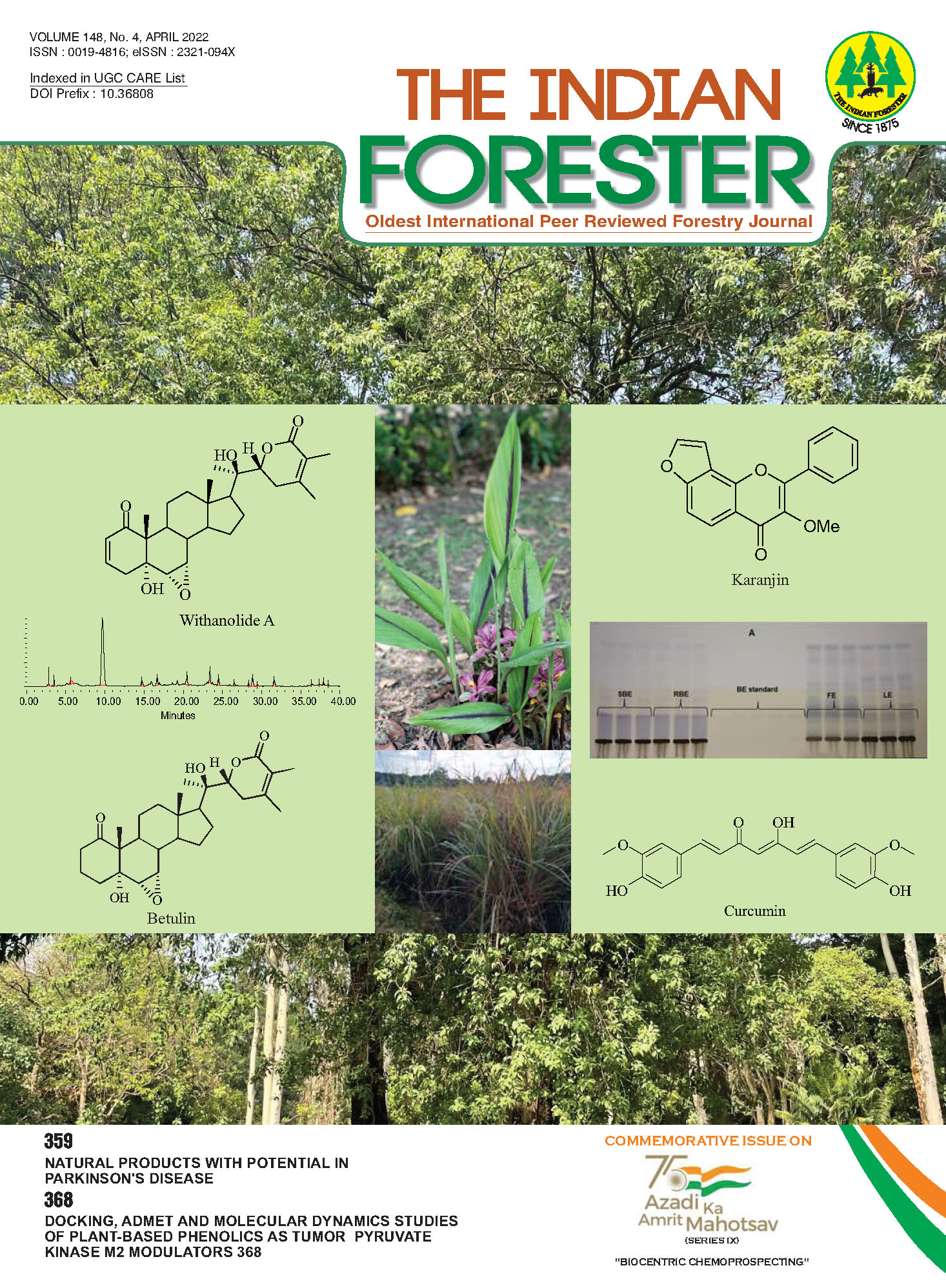Analysis of Phenolics in Clematis gouriana Roxb. Ex Dc. Aerial Parts by HPLC and Method Validation
DOI:
https://doi.org/10.36808/if/2022/v148i4/168879Keywords:
Quantitative Analysis, HPLC, Clematis gouriana, Method Validation.Abstract
Fast and economical analytical methods are required for quality control of herbal medicines/ extracts. So, a simple and accurate RP-HPLC method with photodiode array detection was developed for the identification and quantification of phytochemicals in Clematis gouriana Roxb. ex DC. aerial parts. After several attempts the best HPLC method was developed on Waters C<sub>18</sub> analytical column with column temperature of 30 °C, using a gradient elution solvent consisting of water (0.1% formic acid): acetonitrile at 1mL/min flow rate; and detection was done at 254 and 330 nm. Four phenolic compounds quantified were p-coumaric acid, hyperoside, methyl caffeate, and caffeic acid. Caffeic acid was detected as the major phytoconstituent that may be considered as a marker compound for C. gouriana. Content of the four phenolic compounds extracted by reflux, ultra-sonication, and microwave-assisted extraction was also compared. The developed HPLC method showed good linearity (r<sup>18</sup> >0.998), high precision (<2%) and good recovery (98.8-102.7%) for the studied four compounds, and validation parameters were also found within permissible limits as per the International Council of Harmonization guideline Q2 (R1). To the best of our knowledge, this is the first report on the quantification of phytochemicals and validation of the HPLC method for Clematis gouriana aerial parts.
References
Annon. (2005). Chinese Pharmacopoeia, The Pharmacopoeia Commission of the Ministry of Health of the People's Republic of China.
Barkat M.A., Goyal A., Barkat H.A., Salauddin M., Pottoo F.H. and Anwer E.T. (2021). Herbal Medicine: Clinical Perspective and Regulatory Status. Combinatorial Chemistry and High Throughput Screening, 24: 1573-1582.
Chawla R., Kumar S. and Sharma A. (2012). The genus Clematis (Ranunculaceae): Chemical and pharmacological perspectives. J. Ethnopharmacol., 143: 116-150.
Ekor M. (2014). The growing use of herbal medicines: issues relating to adverse reactions and challenges in monitoring safety. Front. Pharmacol., 4:177.
ICH, Harmonized Tripartite Guidelines. (2005). In: Validation of analytical procedures: text and methodology Q2 (R1), International conference on harmonization, Geneva, Switzerland. pp: 05.
Kshirsagar R. and Singh N. (2001). Some less known ethnomedicinal uses from Mysore and Coorg districts, Karnataka state, India. J. Ethnopharmacol., 75: 231-238.
Quattrocchi U. (2012). CRC world dictionary of medicinal and poisonous plants: common names, scientific names, eponyms, synonyms, and etymology, CRC Press, Boca Raton, Florida, United States.
Rana S., Rawat K., Mahendru M., Padwad Y., Pakade Y.B., Lal B. and Bhushan S. (2015). Screening of bioconstituents and in vitro cytotoxicity of Clematis gouriana leaves. Nat. Prod. Res., 29: 2242-2246.
Raven P.H. and Wu Z.Y. (2001). Flora of China. 6, Caryophyllaceae Through Lardizabalaceae. Science Press. and Missouri Botanical Garden Press, St. Louis.
Sharma B.D. (1984). Flora of Karnataka: analysis. Department of Environment, Botanical Survey of India, Howrah.
Sharma S. and Chunekar K. (1998). Medicinal plants used in Ayurveda. Rashtriya Ayurveda Vidyapeeth, New Delhi.
Sun F., He Q., Xiao P., Muhammad I. and Cheng Y. (2008). Simultaneous quantification of five triterpenoid saponins in Clematis L. Spp. by high-performance liquid chromatography with evaporative light scattering detection. Phytochem. Anal., 19: 40-45.
Tistaert C., Dejaegher B. and Vander Heyden Y. (2011) Chromatographic separation techniques and data handling methods for herbal fingerprints: a review. Anal.Chim Acta., 690: 148-161.
Wang P., Li L., Yang H., Cheng S., Zeng Y., Nie L. and Zang H. (2012). Chromatographic fingerprinting and quantitative analysis for the quality evaluation of Xinkeshu tablet. J. Pharm. Anal., 2: 422-430.
World Health Organization (1991). Guidelines for the Assessment of Herbal Medicines, Munich, 28.6.1991, WHO, Geneva.
World Health Organization (2005). National policy on traditional medicine and regulation of herbal medicines: Report of a WHO global survey. World Health Organization, Geneva, Switzerland.
Downloads
Downloads
Published
How to Cite
Issue
Section
License
Unless otherwise stated, copyright or similar rights in all materials presented on the site, including graphical images, are owned by Indian Forester.





